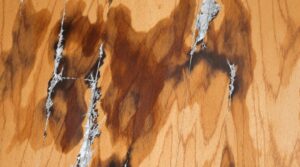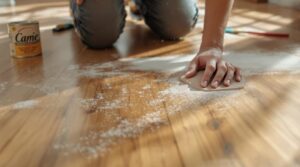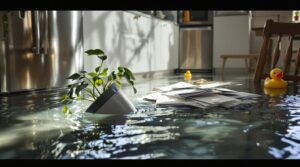Subfloors require immediate replacement when water exposure exceeds 48 hours, structural integrity is compromised, or contamination from sewage occurs. Key indicators include visible warping, discoloration, spongy areas, and musty odors. Professional moisture testing can determine water saturation levels and damage extent. Early detection through systematic inspection prevents extensive damage, while proper assessment by qualified experts guarantees appropriate remediation strategies. Understanding the full scope of water damage enables homeowners to make informed decisions about necessary repairs.
Key Takeaways
- Replace subfloor immediately when exposure to black water or sewage contamination has occurred, as this poses severe health risks.
- Structural deterioration signs like sagging, soft spots, or compromised load-bearing capacity require prompt replacement of the affected subfloor.
- Water exposure lasting more than 48 hours typically necessitates replacement due to high risk of mold growth and material degradation.
- Visible mold or mildew growth on the subfloor indicates serious contamination and requires complete replacement of affected sections.
- Severe warping, separation of materials, or floor instability that compromises structural integrity demands immediate subfloor replacement.
Understanding Subfloor Water Damage
Water damage to subflooring represents one of the most serious threats to a home's structural integrity, as it can compromise the essential layer between floor joists and surface flooring.
The deterioration of subfloor materials can occur through various mechanisms, including frozen pipe bursts, appliance leaks, and inadequate moisture barriers in crawl spaces. Constant pressure from supply hoses in washing machines and dishwashers can eventually lead to catastrophic failures.
Signs of compromised subflooring typically manifest as spongy or springy areas underfoot, loose floorboards, and persistent musty odors.
Water damage prevention requires vigilant maintenance of potential water sources, including proper gutter function, regular inspection of appliance hoses, and adequate vapor barriers.
The presence of mold, stains, or unusual movement in flooring demands immediate attention, as water damage can progress silently for years before becoming visibly apparent, potentially leading to extensive structural issues that require professional intervention.
Common Signs of Water-Damaged Subfloors
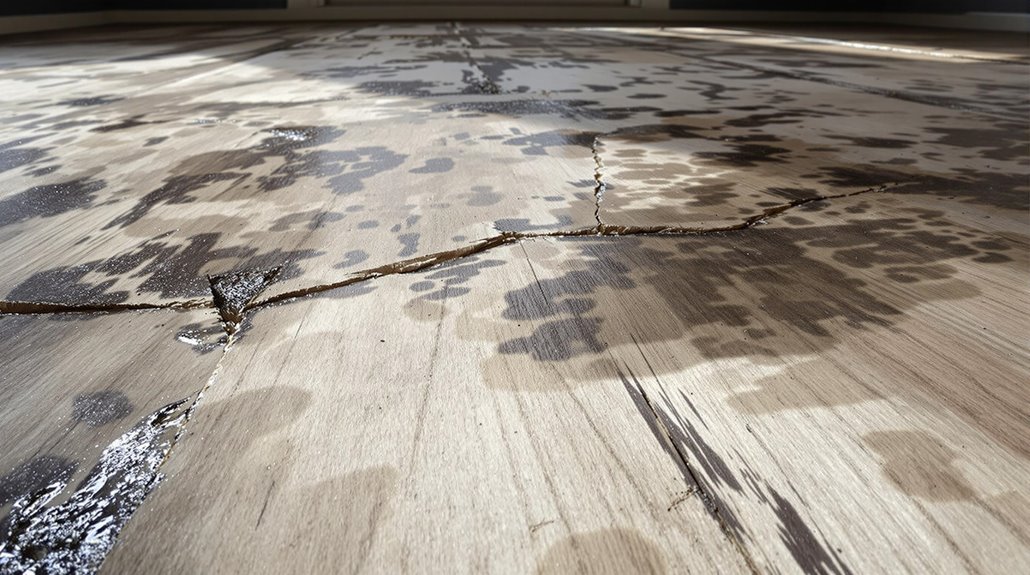
Identifying water damage in subflooring requires attention to both visual indicators and environmental cues.
Key visual warning signs include water stains, discoloration, warping, and separation between flooring materials. Squeaking and creaking while walking across the floor often indicates water has compromised the subfloor structure.
The presence of persistent musty odors often confirms moisture-related deterioration, even when visual evidence may be subtle or concealed beneath surface materials.
Visual Warning Signs
When inspecting a subfloor for potential replacement needs, homeowners should recognize several telltale visual indicators of water damage.
Subfloor materials exposed to moisture often exhibit distinct patterns of deterioration that signal the need for immediate attention. Bouncy or sagging floors during a walkthrough indicate serious moisture-related structural compromise. Water testing may reveal the extent of damage beneath surface-level symptoms.
Common visual warning signs include:
- Dark stains or discoloration patches spreading across flooring surfaces
- Warping, buckling, or noticeable gaps between flooring and walls
- Visible mold or mildew growth on floors or adjacent wall areas
- Cracking, peeling, or lifting of flooring materials
- Surface irregularities such as uneven spots, dips, or raised sections
These visual indicators often suggest deeper structural issues requiring professional assessment to determine the full scope of necessary repairs or replacement.
Musty Odors Matter
Musty odors emanating from floor surfaces often serve as critical indicators of concealed water damage within subfloor structures. These distinct smells typically result from moisture accumulation caused by various sources, including plumbing failures, roof leaks, or inadequate waterproofing around windows.
The presence of musty odors beneath flooring materials signals potential mold growth and structural deterioration.
Professional assessment becomes essential when detecting these odors, as they frequently indicate extensive damage requiring immediate attention. Early detection and swift response to musty odor sources can prevent severe structural compromise and minimize repair costs.
Restoration specialists can implement targeted drying protocols and evaluate the necessity for partial or complete subfloor replacement. Proper mold growth prevention depends on identifying and eliminating moisture sources while ensuring adequate ventilation during the restoration process.
Working with public adjusters during water damage restoration can significantly increase insurance claim settlements for subfloor replacement costs.
Assessing the Severity of Damage
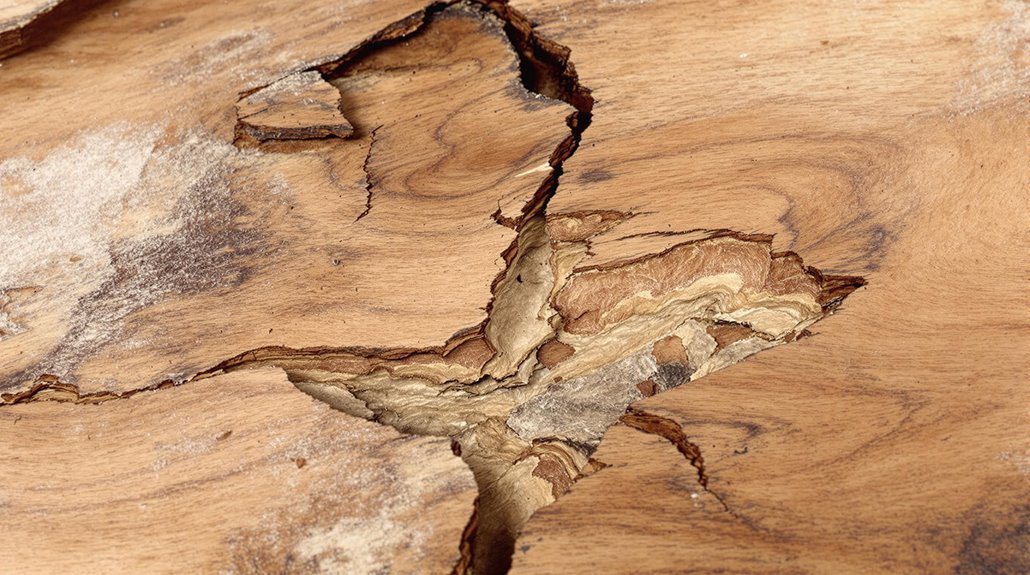
Visual inspection serves as the primary method for evaluating subfloor damage severity, with key indicators including discoloration, warping, and structural instability.
Professional moisture testing using specialized meters can precisely measure water saturation levels in subflooring materials to determine the extent of water infiltration.
The combination of visual assessment and moisture level readings provides essential data for making informed decisions about whether repair or complete replacement is necessary.
Visual Signs Matter Most
Identifying the severity of subfloor damage requires careful observation of multiple visual indicators.
When examining flooring materials for potential subfloor issues, professionals look for specific signs that signal the need for immediate replacement.
Key visual indicators of subfloor damage include:
- Noticeable buckling or warping of floorboards
- Visible mold or mildew growth on surfaces
- Dark spots or patches of discoloration
- Cupping of floorboards where edges rise higher than centers
- Bubbling or cracking in vinyl, laminate, or linoleum
These signs often indicate water damage beneath the surface, potentially compromising the structural integrity of the subfloor.
Early detection through visual inspection can prevent more extensive damage and reduce health risks associated with prolonged exposure to moisture-damaged materials.
Professional assessment becomes essential when multiple visual indicators are present.
Testing Moisture Levels
Accurate moisture testing plays an essential role in determining whether a subfloor requires replacement or can be salvaged through remediation efforts. Professional moisture detection methods range from preliminary assessments to precise measurements using specialized equipment.
| Testing Method | Application | Results |
|---|---|---|
| Plastic Sheet | Surface moisture | Visual darkening after 24h |
| Calcium Chloride | Vapor emission | Quantitative MVER data |
| RH Testing | Internal moisture | Humidity at 40% depth |
| Moisture Meters | Quick scanning | Identifies hot spots |
| Visual Inspection | Surface assessment | Visible damage signs |
Testing methods should be combined for thorough assessment. The Rapid RH L6 system provides detailed concrete moisture data, while the Orion 950 accurately measures wood moisture content. These tools help professionals determine appropriate remediation strategies and identify cases where replacement becomes necessary due to extensive water damage.
Critical Factors That Determine Replacement

Several critical factors must be evaluated to determine whether a subfloor requires replacement rather than repair. The primary replacement criteria include the duration of water exposure, type of contamination, and extent of structural compromise. Additionally, it’s essential to consider the materials used in the subfloor, as some can withstand moisture better than others. Wet subfloor replacement considerations also involve assessing any potential damage to surrounding structures, such as walls and joists, which could exacerbate the problem if not addressed. Finally, the cost-effectiveness and long-term durability of repair versus replacement should be weighed carefully to ensure a sound investment in the property.
Professional assessment helps identify key damage indicators that warrant immediate action.
Key factors determining replacement necessity include:
- Exposure to water exceeding 48 hours, indicating potential mold growth
- Contact with black water or sewage contamination
- Visible structural deterioration such as sagging or soft spots
- Presence of mold or mildew growth
- Compromised load-bearing capacity affecting floor stability
When these conditions exist, particularly in combination, replacement becomes the safest and most cost-effective solution.
This decision protects both the structural integrity of the building and the health of its occupants.
Steps to Inspect Your Subfloor
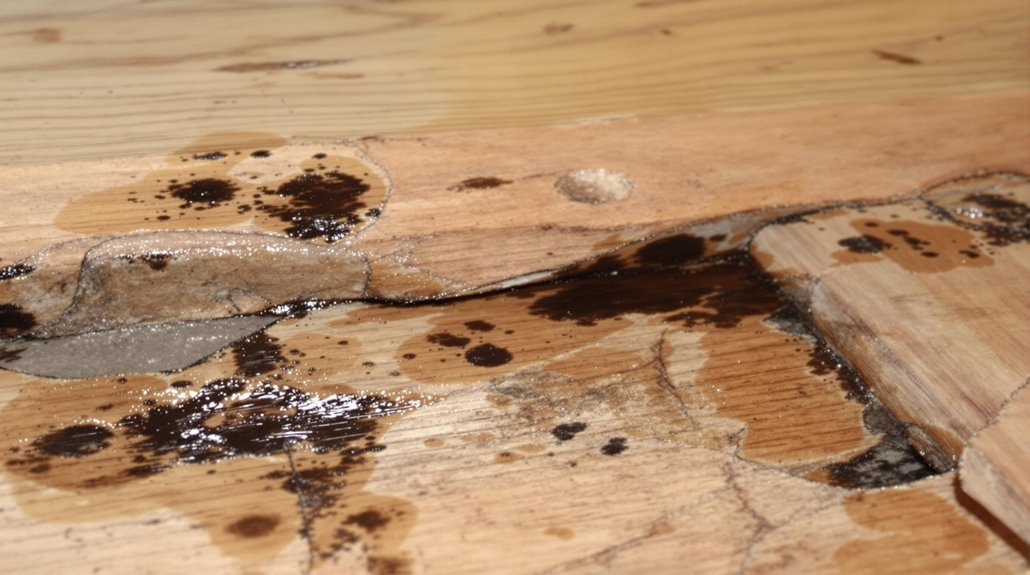
A thorough inspection of the subfloor requires systematic evaluation and proper access to the underlying structure. The process begins with removing baseboards and existing flooring materials to expose the subfloor completely.
Inspectors should start from areas that feel spongy underfoot and work outward, paying close attention to moisture barriers and signs of water infiltration.
Key inspection points include checking for warping, discoloration, and musty odors that might indicate mold growth. The evaluation must assess the structural integrity of subfloor materials, including rot assessment and verification of proper joist bearing.
Compliance with building codes is essential, particularly regarding crawl space ventilation requirements and proper fastener installation. Special attention should focus on areas around plumbing fixtures where water damage commonly occurs.
Professional Assessment Guidelines
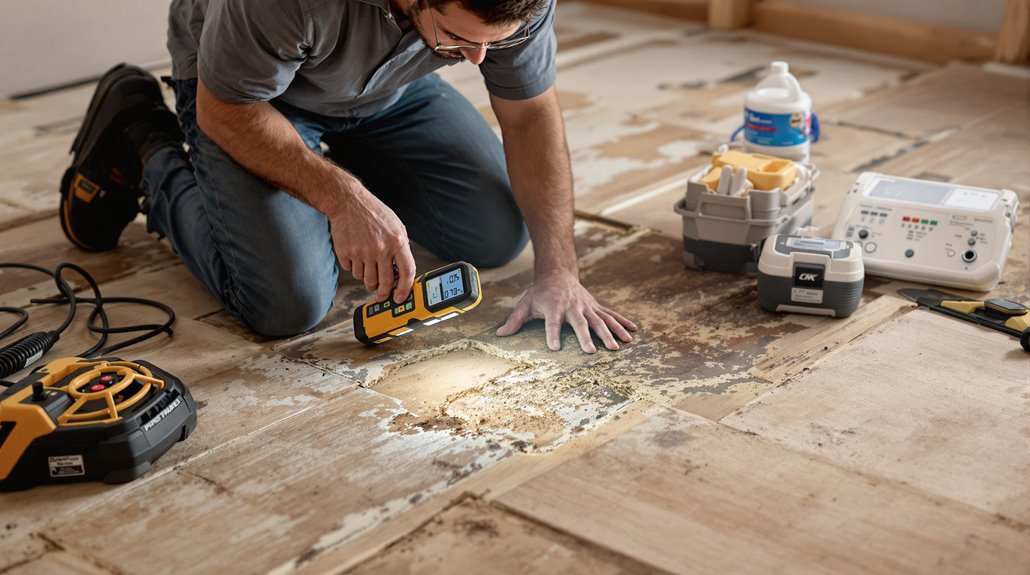
Professional assessment of subfloor damage requires systematic evaluation by qualified restoration specialists using specialized tools and established protocols.
These experts utilize moisture detection equipment to determine the extent of water infiltration and assess the condition of subfloor materials.
- Moisture meters measure water content in affected areas
- Visual inspection identifies visible damage and deformation
- Structural integrity testing evaluates load-bearing capacity
- Surface mapping determines the spread of water damage
- Environmental testing detects potential mold growth
The assessment process involves analyzing multiple factors, including exposure duration, water contamination level, and material composition.
Critical evaluation points focus on structural stability, moisture content readings, and potential health hazards.
This systematic approach guarantees accurate diagnosis and appropriate recommendations for either restoration or replacement of damaged subflooring.
Prevention and Maintenance Tips

Maintaining subfloor integrity through preventive measures greatly reduces the risk of costly repairs and structural damage. Regular preventive maintenance should focus on moisture control through systematic inspections of plumbing systems, roof conditions, and proper ventilation.
Essential strategies include monitoring water bills for unexpected increases, cleaning gutters regularly, and maintaining indoor humidity levels between 30-50% using dehumidifiers and proper HVAC operation.
Installation of moisture barriers and waterproof coatings provides additional protection, while proper drainage systems direct water away from the structure. Homeowners should also guarantee adequate subfloor preparation, including thorough cleaning, leveling, and sealing of any cracks.
Regular inspection of ventilation systems and prompt addressing of condensation issues help prevent moisture accumulation that could compromise subfloor integrity. Working with public adjusters can help maximize insurance settlements by up to 50% when water damage claims become complex.
The Replacement Process
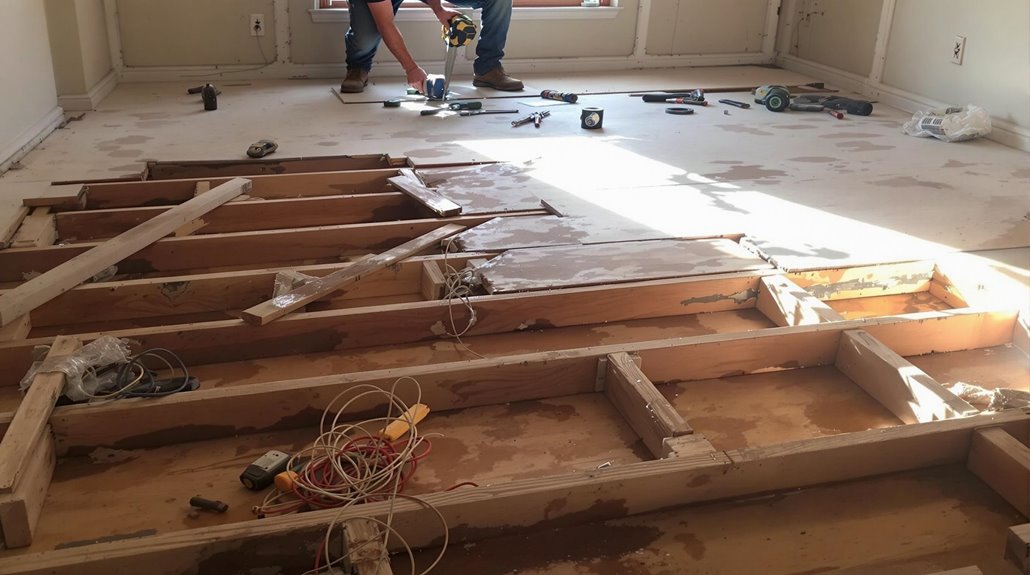
Replacing damaged subfloor requires a systematic approach that begins with thorough damage assessment and preparation. The process involves careful removal of damaged sections, preparation of the workspace, and proper installation techniques to guarantee structural integrity.
Key steps in the replacement process include:
- Remove baseboards and flooring to access damaged subfloor materials
- Cut and remove compromised sections using a circular saw set to one-inch depth
- Inspect and reinforce floor joists if necessary
- Apply subfloor adhesive to prevent squeaking
- Install new subfloor materials with proper fastening methods
During installation, maintain 1/8-inch gaps between panels and keep perimeter fasteners 3/8-inch from edges.
Professional assistance may be necessary for complex situations involving plumbing issues or extensive structural damage. Following proper installation techniques guarantees long-term stability and prevents future problems.
Cost Considerations and Planning

The financial scope of subfloor replacement varies considerably based on multiple factors, with costs typically ranging from $250 to $2,000 for repairs.
A detailed cost breakdown reveals expenses of $1.66 to $5 per square foot, depending on material selection and labor requirements. Bathrooms and kitchens typically incur higher costs due to accessibility challenges and specialized moisture-resistant materials.
When developing budgeting strategies, homeowners should account for both material and labor costs, including potential additional work such as joist replacement or underlayment installation.
Professional assessment is essential for accurate cost estimation, as the extent of damage determines whether partial or complete replacement is necessary.
Early intervention through professional inspection can prevent escalating costs and identify the most cost-effective solution while ensuring structural integrity and safety.
Homeowners insurance may cover subfloor water damage repairs if the cause stems from a covered peril like burst pipes or appliance malfunctions.
The Benefits Of Consulting A Public Adjuster

When dealing with extensive subfloor damage, consulting a public adjuster can greatly improve insurance claim outcomes through their expertise in policy interpretation and damage assessment.
Public adjusters provide objective documentation of damage extent and professionally handle all aspects of the claims process, from initial inspection through final settlement negotiations.
Their involvement often results in higher claim settlements due to their thorough understanding of coverage limits, proper damage valuation, and established negotiation strategies with insurance carriers.
Studies show that policyholders working with licensed public adjusters receive significantly higher settlements, with increases up to 500% on non-catastrophic claims like water damage.
Expertise In Insurance Claims
Since subfloor replacement often involves substantial costs and complex insurance claims, consulting a public adjuster can provide essential expertise in managing the claims process.
Public adjusters possess specialized insurance claim strategies and maintain professional qualifications required by state insurance departments. Their expertise enables thorough damage assessments and accurate claim documentation.
- Licensed professionals who understand policy terminology and coverage limits
- Experienced in identifying both visible and hidden water damage to subflooring
- Skilled at documenting structural damage evidence for maximum claim value
- Trained in current construction costs and repair methodologies
- Knowledgeable about local building codes and compliance requirements
These experts work directly for homeowners, negotiating with insurance companies to guarantee fair compensation while operating on a contingency basis, typically charging up to 10% of the settlement amount.
Working with insurance policy experts can yield higher payouts and reduce stress during the claims process, as they specialize in identifying potential coverage pitfalls.
Objective Damage Assessment
Professional damage assessment through a public adjuster provides homeowners with extensive, unbiased evaluations of subfloor conditions.
Using advanced tools like moisture meters and thermal imaging, adjusters detect hidden water damage and assess structural safety beyond visible surface deterioration.
Public adjusters document subfloor materials and existing damage thoroughly, ensuring insurance claims cover all necessary repair methods and restoration techniques.
Their expertise helps identify potential issues like mold prevention needs and moisture control requirements that might otherwise go unnoticed.
This detailed evaluation of property preservation needs leads to more accurate claim documentation and better coverage under insurance policies.
Streamlined Claim Process
Working with a public adjuster greatly streamlines the insurance claim process for subfloor damage by eliminating common delays and complications.
Through streamlined documentation and efficient negotiations, public adjusters guarantee maximum claim settlements while reducing stress for property owners.
Key advantages of utilizing a public adjuster include:
- Professional management of all claim documentation and paperwork
- Expert policy interpretation to guarantee complete coverage compliance
- Direct handling of insurance company communications
- Accelerated claim resolution through proactive issue management
- Strategic negotiation to secure fair compensation for all damages
This professional approach allows property owners to focus on necessary repairs while the adjuster handles the complex aspects of the claim process, ultimately leading to faster subfloor replacement and property restoration.
Higher Claim Payouts & Settlements
Beyond streamlining the claims process, public adjusters consistently secure higher settlement amounts for subfloor damage claims through their expertise and strategic negotiation skills.
Their thorough understanding of policy terms enables them to identify all covered damages and implement effective claim strategies.
These professionals excel in insurance negotiation by accurately documenting the full extent of subfloor water damage, including hidden issues that property owners might overlook.
Working on a contingency basis, typically charging up to 10% of the settlement, public adjusters are motivated to maximize claim payouts.
Their expertise in policy interpretation and skilled representation often results in settlements that not only cover their fees but provide substantially higher compensation compared to claims filed without professional assistance.
This approach guarantees property owners receive fair value for their subfloor replacement needs.
About The Public Claims Adjusters Network (PCAN)
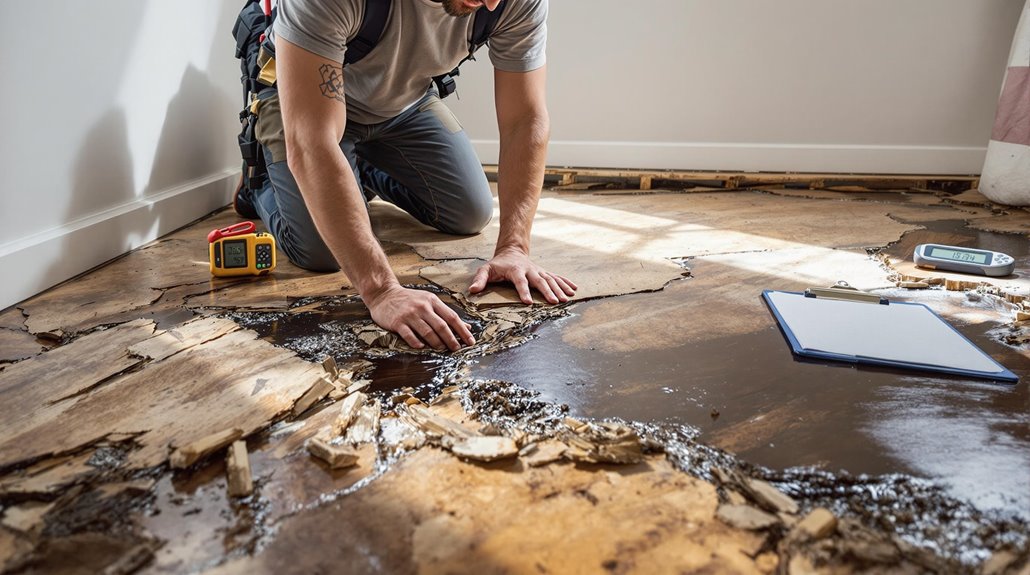
Independent advocates in the insurance industry, public claims adjusters serve as essential intermediaries between policyholders and insurance companies. These licensed professionals specialize in analyzing insurance policies, validating claims, and securing fair compensation for property owners facing water damage and other losses.
Key services provided by public adjusters include:
- Thorough damage assessment and documentation
- Detailed analysis of insurance policy coverage
- Expert calculation of repair and replacement costs
- Complete management of claim filing and communications
- Strategic negotiation of settlement terms
The Public Claims Adjusters Network (PCAN) operates nationwide, offering both residential and commercial claims management services.
Their expertise in construction costs and repair scope guarantees accurate damage assessments, while their deep understanding of insurance processes helps streamline claims for best outcomes.
Frequently Asked Questions
Can a Water-Damaged Subfloor Be Saved if It's Only Partially Wet?
Like rescuing a sinking ship, a partially wet subfloor can be salvaged through rapid drying techniques and moisture detection methods, provided structural integrity remains intact and proper subfloor repair techniques are implemented.
How Long Does It Typically Take for Mold to Develop in Wet Subflooring?
Mold growth typically initiates within 24-48 hours when moisture levels remain elevated in subflooring. Significant colonization can occur within 72 hours under favorable temperature and humidity conditions.
Will Homeowner's Insurance Cover Subfloor Replacement Due to Water Damage?
Homeowner's insurance policies typically cover subfloor replacement when water damage is sudden and accidental, subject to coverage limits, but exclude gradual deterioration or maintenance-related issues.
What's the Difference Between Water Damage From Floods Versus Plumbing Leaks?
Floods typically cause immediate, widespread flood impact affecting large areas, while plumbing leaks often result in localized, gradual leak severity that may go undetected longer, creating different damage patterns and remediation requirements.
Can I Install New Flooring Over a Slightly Water-Damaged Subfloor?
Like quicksand beneath a castle, damaged subfloors require thorough inspection before installation. Professional subfloor inspection guarantees proper assessment, as installing new flooring over compromised surfaces risks future durability and safety concerns.
References
- https://www.baycrawlspace.com/what-to-do-about-water-damaged-subfloor/
- https://rainbowrestores.com/blog/do-i-need-to-replace-my-water-damaged-subfloor
- https://academyhouseleveling.com/top-3-indicators-of-damaged-subflooring-in-your-home/
- https://majorrs.com/when-to-replace-subfloor-from-water-damage/
- https://www.flooringhq.com/wood-flooring/signs-your-subfloor-needs-to-be-replaced/
- https://kicrestoration.com/what-4-reasons-why-wet-subfloor/
- https://dryforcecorp.com/how-to-fix-subfloors-with-severe-water-damage/
- https://www.bessemeter.com/blog/subfloor-issues/
- https://www.truesouthhomeinspection.com/signs-your-subfloor-may-be-incorrectly-installed-or-damaged/
- https://www.servicemasterrestore.com/servicemaster-by-cornerstone/why-us/blog/2024/december/common-signs-of-water-damaged-floors-and-how-to-address-them/


